Khoekhoe
Khoekhoen[lower-alpha 1] (or Khoikhoi in the former orthography; formerly also Hottentots[2]) are the traditionally nomadic pastoralist indigenous population of southwestern Africa. They are often grouped with the hunter-gatherer San (literally "Foragers") peoples.[3] The designation "Khoekhoe" is actually a kare or praise address, not an ethnic endonym, but it has been used in the literature as an ethnic term for Khoe-speaking peoples of Southern Africa, particularly pastoralist groups, such as the !Ora, !Gona, Nama, Xiri and ǂNūkhoe nations.
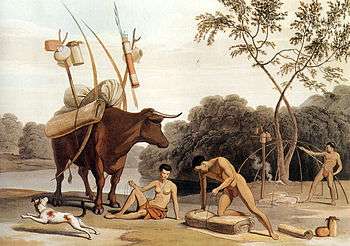
While it is clear that the presence of Khoekhoen in southern Africa would predate the postulated "Bantu expansion", it is not certain by how much (possibly in the Late Stone Age).[3] Khoekhoen maintained large herds of Nguni cattle in the Cape region at the time of VOC colonisation in the 17th century. Their nomadic pastoralism was mostly discontinued in the 19th to 20th century.[4]
Their Khoekhoe language is related to certain dialects spoken by foraging San peoples of the Kalahari, such as the Khwe and Tshwa, forming the Khoe language family. The main Khoekhoe subdivisions today are the Nama people of Namibia, Botswana and South Africa (with numerous clans), the ǂNūkhoeǃhaos of Namibia, the !Orana clans of South Africa (such as ǀHõakhoena or AmaNgqosini), the Xirikua or Griekwa nation of South Africa, and the AmaGqunukhwebe or !Gona clans which fall under the Xhosa-speaking polities.
The Xirikua clans (Griqua) developed their own ethnic identity in the 19th century and settled in Griqualand. They are related to the same kinds of clan formations as the Rehoboth Basters, who could also be considered a "Khoekhoe" people.
History
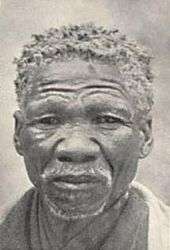
Early history
The broad ethnic designation of "Khoekhoen", meaning the peoples originally part of a pastoral culture and language group to be found across Southern Africa, is thought to refer to a population originating in the northern area of modern Botswana. This culture steadily spread southward, eventually reaching the Cape approximately 2,000 years ago. "Khoekhoe" groups include ǀAwakhoen to the west, and ǀKx'abakhoena of South and mid-South Africa, and the Eastern Cape. Both of these terms mean "Red People", and are equivalent to the IsiXhosa term "amaqaba". Husbandry of sheep, goats and cattle grazing in fertile valleys across the region provided a stable, balanced diet, and allowed these lifestyles to spread, with larger groups forming in a region previously occupied by the subsistence foragers. Ntu-speaking agriculturalist culture is thought to have entered to region in the 3rd century CE, pushing pastoralists into the Western areas. The example of the close relation between the ǃUriǁ’aes (High clan), a cattle keeping population, and the !Uriǁ’aeǀ’ona (High clan children), a more-or-less sedentary forager population (also known as "Strandlopers"), both occupying the area of ǁHuiǃgaeb, shows that the strict distinction between these two lifestyles is unwarranted, as well as the ethnic categories that are derived. Foraging peoples who ideologically value non-accumulation as a social value system would be distinct, however, but the distinctions among “Khoekhoe pastoralists”, “San hunter-gatherers” and “Bantu agriculturalists” do not hold up to scrutiny, and appear to be historical reductionism.[5]
Arrival of Europeans
Khoe-speaking peoples traded with seafarers from all over the globe for centuries, going back into ancient times, and this undoubtedly included some Europeans, perhaps even Roman vessels, but Portuguese explorers and merchants are the first to record their contacts, in the 15th and 16th centuries CE. The ongoing encounters were often violent. In 1510, at the Battle of Salt River, Francisco de Almeida and fifty of his men were killed and his party were defeated[6] by ox-mounted !Uriǁ’aekua ("Goringhaiqua" in Dutch approximate spelling), which was one of the so-called Khoekhoe clans of the area that also included the !Uriǁ’aeǀ’ona ("Goringhaicona", also known as "Strandlopers"), said to be the ancestors of the !Ora nation of today. In the late 16th century, Portuguese, French, Danish, Dutch and English but mainly Portuguese ships regularly continued to stop over in Table Bay en route to the Indies. They traded tobacco, copper and iron with the Khoekhoe-speaking clans of the region, in exchange for fresh meat.
Local population dropped after smallpox contagion was spread through European activity. The Khoe-speaking clans suffered high mortality as immunity to the disease was rare. This increased, as military conflict with the intensification of the colonial expansion of the United East India Company that began to enclose traditional grazing land for farms. Over the following century, the Khoe-speaking peoples were steadily driven off their land, resulting in numerous northwards migrations, and the reformulation of many nations and clans, as well as the dissolution of many traditional structures.
"Khoekhoe" social organisation was thus profoundly damaged by the colonial expansion and land seizure from the late 17th century onwards. As social structures broke down, many Khoekhoen settled on farms and became bondsmen (bondservants, serfs) or farm workers; others were incorporated into clans that persisted. Georg Schmidt, a Moravian Brother from Herrnhut, Saxony, now Germany, founded Genadendal in 1738, which was the first mission station in southern Africa,[7] among the Khoe-speaking peoples in Baviaanskloof in the Riviersonderend Mountains.
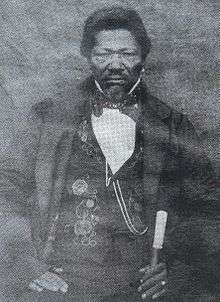
The colonial designation of "Baasters" came to refer to any clans that had European ancestry in some part and adopted certain Western cultural traits. Though these were later known as Griqua (Xirikua or Griekwa) they were known at the time as "Basters" and in some instances are still so called, e. g., the Bosluis Basters of the Richtersveld and the Baster community of Rehoboth, Namibia, mentioned above.
Arguably responding to the influence of missionaries, the states of Griqualand West and Griqualand East were established by the Kok dynasty; these were later absorbed into the Cape Colony of the British Empire.
Beginning in the late 18th century, Oorlam communities migrated from the Cape Colony north to Namaqualand. They settled places earlier occupied by the Nama. They came partly to escape Dutch colonial conscription, partly to raid and trade, and partly to obtain herding lands.[8] Some of these emigrant Oorlams (including the band led by the outlaw Jager Afrikaner and his son Jonker Afrikaner in the Transgariep) retained links to Oorlam communities in or close to the borders of the Cape Colony. In the face of gradual Boer expansion and then large-scale Boer migrations away from British rule at the Cape, Jonker Afrikaner brought his people into Namaqualand by the mid-19th century, becoming a formidable force for Oorlam domination over the Nama and against the Bantu-speaking Hereros for a period.[9]
Kat River settlement (1829–1856) and Khoena in the Cape Colony
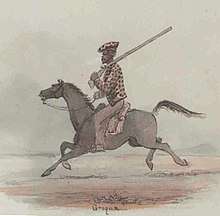
By the early 1800s, the remaining Khoe-speakers of the Cape Colony suffered from restricted civil rights and discriminatory laws on land ownership. With this pretext, the powerful Commissioner General of the Eastern Districts, Andries Stockenstrom, facilitated the creation of the "Kat River" Khoe settlement near the eastern frontier of the Cape Colony. The more cynical motive was probably to create a buffer-zone on the Cape's frontier, but the extensive fertile land in the region allowed people to own their land and build communities in peace. The settlements thrived and expanded, and Kat River quickly became a large and successful region of the Cape that subsisted more or less autonomously. The people were predominantly Afrikaans-speaking !Gonakua, but the settlement also began to attract other diverse groups.
Khoekua were known at the time for being very good marksmen, and were often invaluable allies of the Cape Colony in its frontier wars with the neighbouring Xhosa politics. In the Seventh Frontier War (1846–1847) against the Gcaleka, the Khoekua gunmen from Kat River distinguished themselves under their leader Andries Botha in the assault on the "Amatola fastnesses". (The young John Molteno, later Prime Minister, led a mixed Commando in the assault, and later praised the Khoekua as having more bravery and initiative than most of his white soldiers.)[10]
However harsh laws were still implemented in the Eastern Cape, to encourage the Khoena to leave their lands in the Kat River region and to work as labourers on white farms. The growing resentment exploded in 1850. When the Xhosa rose against the Cape Government, large numbers Khoeǀ’ona joined the Xhosa rebels for the first time.[11] After the defeat of the rebellion and the granting of representative government to the Cape Colony in 1853, the new Cape Government endeavoured to grant the Khoena political rights to avert future racial discontent. Attorney General William Porter was famously quoted as saying that he "would rather meet the Hottentot at the hustings, voting for his representative, than meet him in the wilds with his gun upon his shoulder".[12] Thus, the government enacted the Cape franchise in 1853, which decreed that all male citizens meeting a low property test, regardless of colour, had the right to vote and to seek election in Parliament. However, this non-racial principle was eroded in the late 1880s by a literacy test, and later abolished by the Apartheid Government.[13]
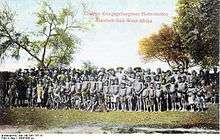
Massacres in German South-West Africa
From 1904 to 1907, the Germans took up arms against the Khoikhoi group living in what was then German South-West Africa, along with the Herero. Over 10,000 Nama, more than half of the total Nama population at the time, may have died in the conflict. This was the single greatest massacre ever witnessed by the Khoikhoi people.[14][15]
Culture
Religion
The religious mythology of the Khoe-speaking cultures gives special significance to the Moon, which may have been viewed as the physical manifestation of a supreme being associated with heaven. Thiǁoab is also believed to be the creator and the guardian of health, while ǁGaunab is primarily an evil being, who causes sickness or death.[16] Many Khoe-speakers have converted to Christianity and Nama Muslims make up a large percentage of Namibia's Muslims.[17]
World Heritage
UNESCO has recognised Khoe-speaking culture through its inscription of the Richtersveld as a World Heritage Site. This important area is the only place where transhumance practices associated with the culture continue to any great extent.
The International Astronomical Union named the primary component of the binary star Mu¹ Scorpii after the traditional Khoekhoe language name Xami di mûra ('eyes of the lion').[18]
Early European theories about Khoekhoe origins
European theories about the origins of the Khoekhoe are historically interesting in their own right. Of the European theories proposed, notable is that summarised in the commissioned Grammar and Dictionary of the Zulu Language.[19] Published in 1859, this put forward the idea of an origin from Egypt that appears to have been popular amongst men of learning in the region.[20] The reasoning for this included the (supposed) distinctive Caucasian elements of the Khoekhoe's appearance, a "wont to worship the moon'", an apparent similarity to the antiquities of Old Egypt, and a "very different language" to their neighbours. The Grammar says that "the best philologists of the present day ... find marked resemblances between the two". This conviction is echoed in an introduction to the Zulu language, which avidly often comments upon the language's various resemblances to Hebrew.
See also
Notes
- This is the native praise address, khoe-khoe "men of men" or "proper humans", as it were, from khoe "human being".[1]
Pronunciation in the Khoekhoe language: kxʰoekxʰoe.
References
- "The old Dutch also did not know that their so-called Hottentots formed only one branch of a wide-spread race, of which the other branch divided into ever so many tribes, differing from each other totally in language [...] While the so-called Hottentots called themselves Khoikhoi (men of men, i.e. men par excellence), they called those other tribes Sā, the Sonqua of the Cape Records [...] We should apply the term Hottentot to the whole race, and call the two families, each by the native name, that is the one, the Khoikhoi, the so-called Hottentot proper; the other the Sān (Sā) or Bushmen." Theophilus Hahn, Tsuni-||Goam: The Supreme Being to the Khoi-Khoi (1881), p. 3.
- "Hottentot, n. and adj." OED Online, Oxford University Press, March 2018, www.oed.com/view/Entry/88829. Accessed 13 May 2018. Citing G. S. Nienaber, 'The origin of the name “Hottentot” ', African Studies, 22:2 (1963), 65-90, doi:10.1080/00020186308707174. See also Rev. Prof Johannes Du Plessis, B.A., B.D. (1917). "Report of the South African Association for the Advancement of Science". pp. 189–193. Retrieved 5 July 2010.CS1 maint: multiple names: authors list (link). Strobel, Christoph (2008). "A Note on Terminology". The Testing Grounds of Modern Empire: The Making of Colonial Racial Order in the American Ohio Country and the South African Eastern Cape, 1770s–1850s. Peter Lang. Desmond, Adrian; Moore, James (2014). "Living in Slave Countries". Darwin's Sacred Cause: How a Hatred of Slavery Shaped Darwin's Views on Human Evolution. Houghton Mifflin Harcourt. p. 103. ISBN 9780547527758.Jeremy I. Levitt, ed. (2015). "Female "things" in international law". Black Women and International Law. Cambridge University Press. p. 291. "Bring Back the 'Hottentot Venus'". Web.mit.edu. 15 June 1995. Retrieved 13 August 2012. "Hottentot". American Heritage Dictionary of the English Language (Fifth ed.). Boston: Houghton Mifflin. 2011. "'Hottentot Venus' goes home". BBC News. 29 April 2002. Retrieved 13 August 2017.
- Alan Barnard (1992). Hunters and Herders of Southern Africa: A Comparative Ethnography of the Khoisan Peoples. New York; Cambridge: Cambridge University Press. ISBN 978-0-521-42865-1.
-
Richards, John F. (2003). "8: Wildlife and Livestock in South Africa". The Unending Frontier: An Environmental History of the Early Modern World. California World History Library. 1. Berkeley, California: University of California Press. p. 296. ISBN 9780520939356. Retrieved 17 November 2016.
The nomadic pastoral Khoikhoi kraals were dispersed and their organization and culture broken. However, their successors, the trekboers and their Khoikhoi servants, managed flocks and herds similar to those of the Khoikhois. The trekboers had adapted to African-style, extensive pastoralism in this region. In order to obtain optimal pasture for their animals, early settlers imitated the Khoikhoi seasonal transhumance movements and those observed in the larger wild herbivores.
- Alan Barnard (2008). "Ethnographic analogy and the reconstruction of early Khoekhoe society" (PDF). Southern African Humanities, vol. 20, pp. 61-75.
- Hamilton, Carolyn, (ed.) Mbenga, Bernard, (ed.) Ross, Robert, 1949 July 26- (ed.) (2011). "Khoesan and Immigrants". The Cambridge history of South Africa: 1885-1994. 1. Cambridge University Press. pp. 168–173. ISBN 9780521517942. OCLC 778617810.CS1 maint: multiple names: authors list (link) CS1 maint: extra text: authors list (link)
- The Pear Tree Blossoms, Bernhard Krueger, Hamburg, Germany
- J. D. Omer-Cooper, History of Southern Africa (Portsmouth, NH: Heinemann, 1987), 263; Nigel Penn, "Drosters of the Bokkeveld and the Roggeveld, 1770–1800," in Slavery in South Africa: Captive Labor on the Dutch Frontier, ed. Elizabeth A. Eldredge and Fred Morton (Boulder, CO: Westview, 1994), 42; Martin Legassick, "The Northern Frontier to ca. 1840: The rise and decline of the Griqua people," in The Shaping of South African Society, 1652–1840, ed. Richard Elphick & Hermann Giliomee (Middletown, Connecticut: Wesleyan U. Press, 1988), 373–74.
- Omer-Cooper, 263-64.
- Molteno, P. A. (1900). The life and times of Sir John Charles Molteno, K. C. M. G., First Premier of Cape Colony, Comprising a History of Representative Institutions and Responsible Government at the Cape. London: Smith, Elder & Co.
- Osterhammel, Jürgen (2015). The Transformation of the World: A Global History of the Nineteenth Century. Translated by Patrick Camiller. Princeton, New Jersey; Oxford: Princeton University Press. p. 251. ISBN 9780691169804.
- Vail, Leroy, ed. (1989). The Creation of Tribalism in Southern Africa. Berkeley: University of California Press. ISBN 0520074203. Retrieved 7 April 2015.
- Fraser, Ashleigh (3 June 2013). "A Long Walk To Universal Franchise in South Africa". HSF.org.za. Retrieved 7 April 2015.
- Jeremy Sarkin-Hughes (2008) Colonial Genocide and Reparations Claims in the 21st Century: The Socio-Legal Context of Claims under International Law by the Herero against Germany for Genocide in Namibia, 1904–1908, p. 142, Praeger Security International, Westport, Conn. ISBN 978-0-313-36256-9
- Moses, A. Dirk (2008). Empire, Colony, Genocide: Conquest, Occupation and Subaltern Resistance in World History. New York: Berghahn Books. ISBN 9781845454524.CS1 maint: uses authors parameter (link)
- "Reconstructing the Past – the Khoikhoi: Religion and Nature".
- "Islam in Namibia, making an impact". Islamonline.net.
- "IAU Approves 86 New Star Names From Around the World" (Press release). IAU.org. 11 December 2017.
- "Grammar and Dictionary of the Zulu Language". Journal of the American Oriental Society. 4: 456. 1854. doi:10.2307/592290. ISSN 0003-0279. JSTOR 592290.
- Grout, Lewis (1859). The Isizulu: a revised edition of a Grammar of the Zulu Language, etc. London: Trübner & Co.
Further reading
- P. Kolben, Present State of the Cape of Good Hope (London, 1731–38);
- A. Sparman, Voyage to the Cape of Good Hope (Perth, 1786);
- Sir John Barrow, Travels into the Interior of South Africa (London, 1801);
- Bleek, Wilhelm, Reynard the Fox in South Africa; or Hottentot Fables and Tales (London, 1864);
- Emil Holub, Seven Years in South Africa (English translation, Boston, 1881);
- G. W. Stow, Native Races of South Africa (New York, 1905);
- A. R. Colquhoun, Africander Land (New York, 1906);
- L. Schultze, Aus Namaland und Kalahari (Jena, 1907);
- Meinhof, Carl, Die Sprachen der Hamiten (Hamburg, 1912);
- Richard Elphick, Khoikhoi and the Founding of White South Africa (London, 1977)
External links
| Wikimedia Commons has media related to Khoikhoi. |
| Wikisource has the text of the 1911 Encyclopædia Britannica article Hottentots. |